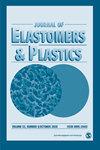Influence of Glycols on the Glycolysis Process and the Structure and Properties of Polyurethane Elastomers
IF 1.6
4区 材料科学
Q4 MATERIALS SCIENCE, MULTIDISCIPLINARY
引用次数: 21
Abstract
In this work, the influence of glycols on the glycolysis process and the properties of obtained polyurethanes were investigated. The glycolysates were produced via glycolysis of waste polyurethane foam in the reaction with one of the following glycols: 1,3-propanediol, 1,5-pentanediol, and 1,6-hexanediol.The reactions were carried out for different mass ratios of polyurethane wastes to glycolysis agent, i.e. 6:1, 8:1, and 10:1. Polyurethanes were synthesized from the obtained intermediates by a one-step method of mixing polymeric di-isocyanate and the glycolysis products with molecular masses ranging from 700 to 1000, while a polyol (Poles 55/20) was used as a chain elongation agent. The influence of glycolysates on tensile strength and elongation at break of polyurethanes was investigated using a Zwick universal tensile tester. Thermal decomposition of the obtained glycolysates and polyurethanes was investigated by thermogravimetry coupled with Fourier transform infrared spectroscopy. It has been found that of all used glycols, 1,6-hexanediol gives the best improvement in the thermal stability of polyurethanes during the glycolysis process. The mean hardness of polyurethanes decreases but rebound resilience increases with chain length of the glycol used for obtaining glycolysates.乙二醇对聚氨酯弹性体糖酵解过程及结构与性能的影响
研究了醇对糖酵解过程和所得聚氨酯性能的影响。该糖酵解产物是由废聚氨酯泡沫与以下三种乙二醇之一:1,3-丙二醇、1,5-戊二醇和1,6-己二醇进行糖酵解制备的。研究了不同质量比的聚氨酯废弃物与糖酵解剂的反应,分别为6:1、8:1和10:1。以聚异氰酸酯和分子量为700 ~ 1000的糖酵解产物为原料,以聚多元醇(poles55 /20)为链长剂,一步法合成聚氨酯。采用Zwick万能拉伸试验机研究了糖酵解物对聚氨酯拉伸强度和断裂伸长率的影响。用热重法和傅里叶变换红外光谱法对所得糖酵解物和聚氨酯的热分解进行了研究。研究发现,在所有使用的乙二醇中,1,6-己二醇在糖酵解过程中对聚氨酯的热稳定性有最好的改善。随着醇链长度的增加,聚氨酯的平均硬度降低,但回弹弹性增加。
本文章由计算机程序翻译,如有差异,请以英文原文为准。
求助全文
约1分钟内获得全文
求助全文
来源期刊

Journal of Elastomers and Plastics
工程技术-材料科学:综合
CiteScore
3.30
自引率
5.90%
发文量
41
审稿时长
6 months
期刊介绍:
The Journal of Elastomers and Plastics is a high quality peer-reviewed journal which publishes original research on the development and marketing of elastomers and plastics and the area in between where the characteristics of both extremes are apparent. The journal covers: advances in chemistry, processing, properties and applications; new information on thermoplastic elastomers, reinforced elastomers, natural rubbers, blends and alloys, and fillers and additives.
 求助内容:
求助内容: 应助结果提醒方式:
应助结果提醒方式:


